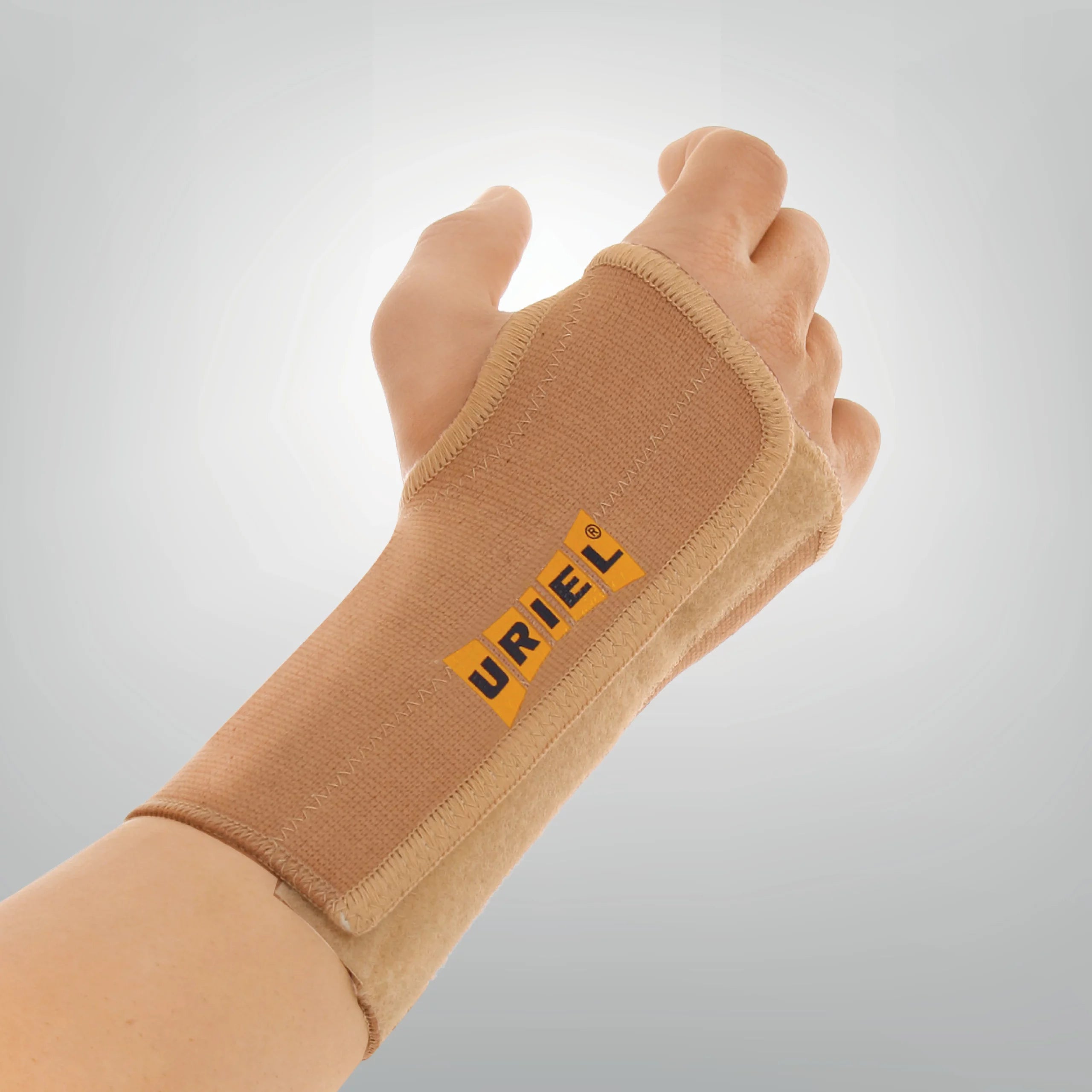
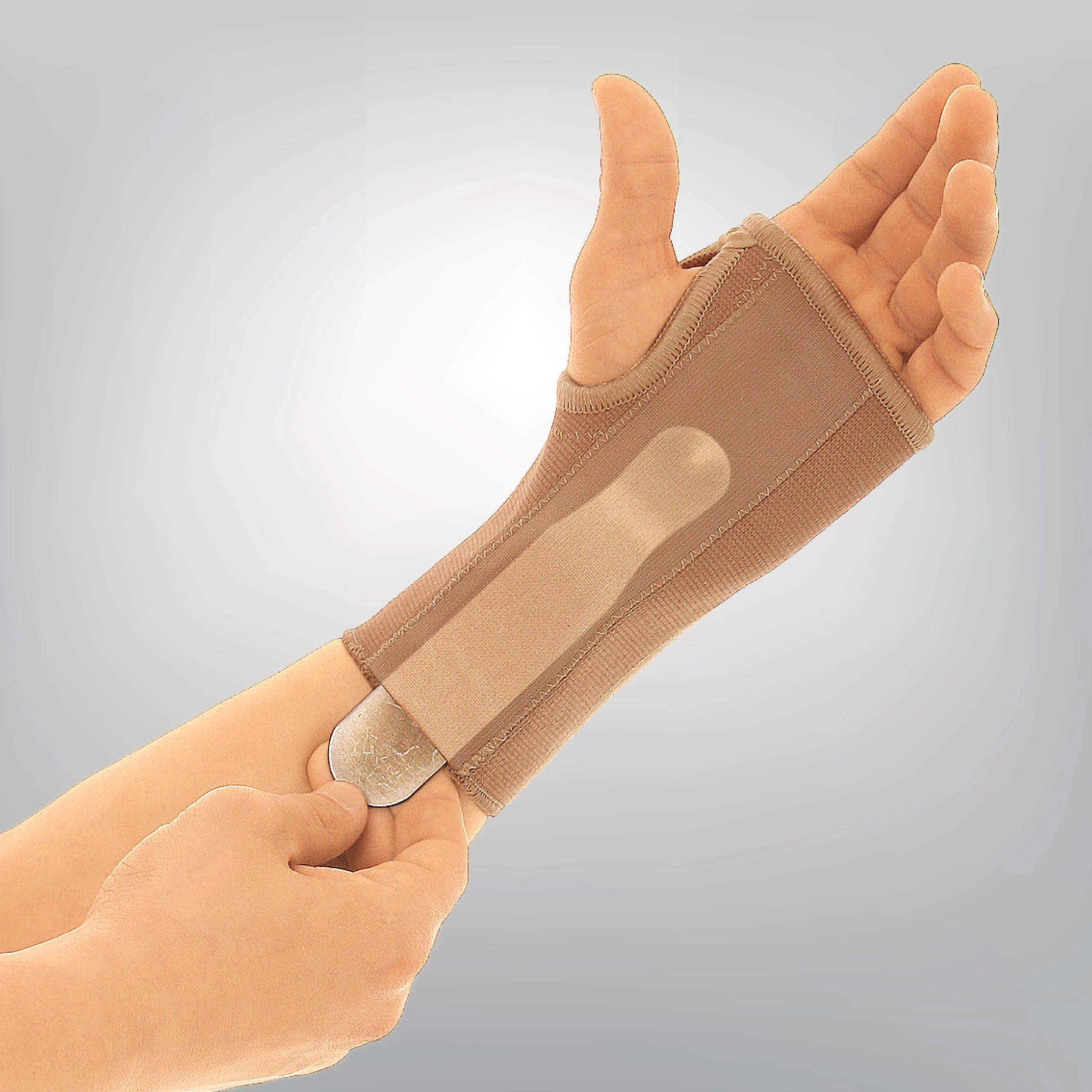
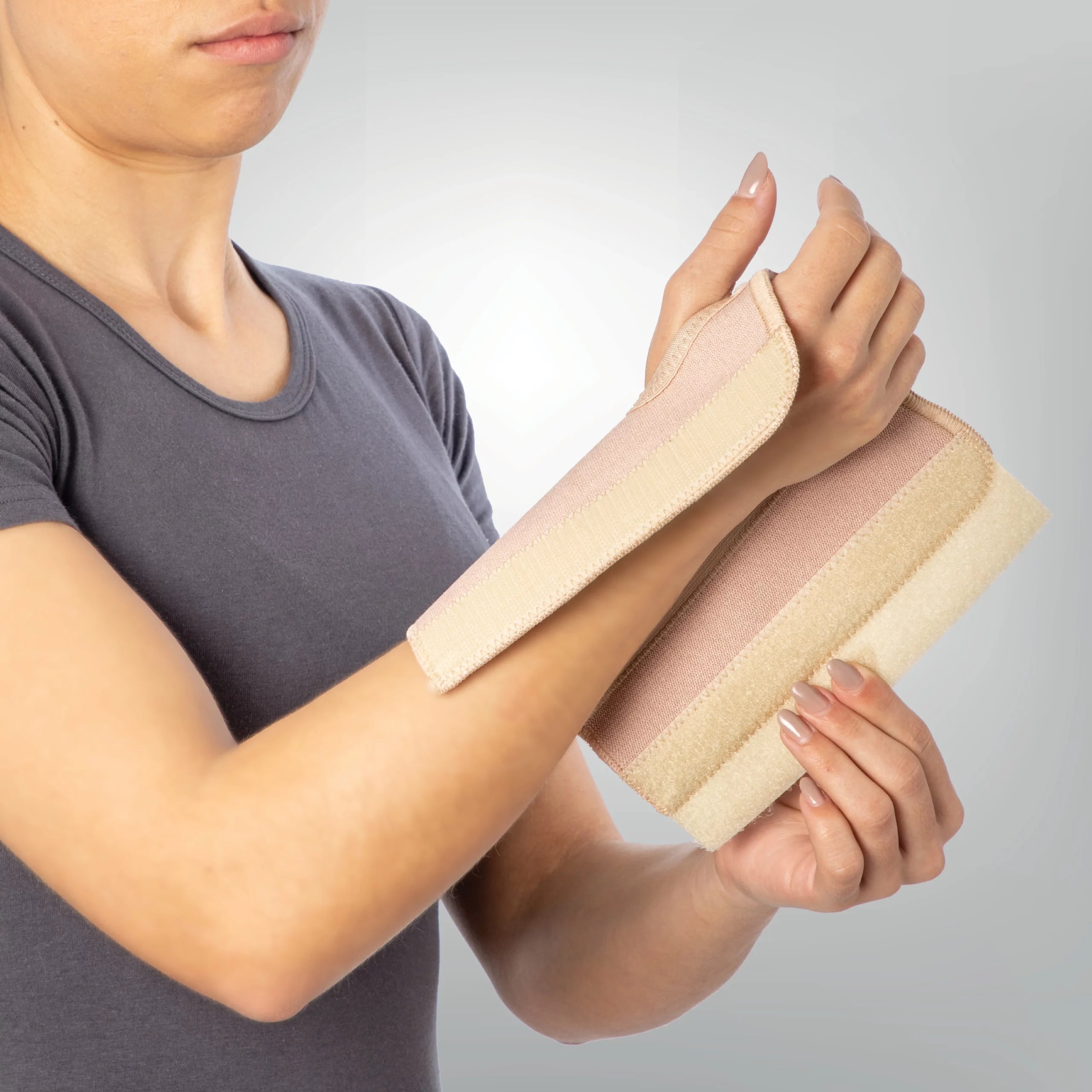

Wrist support brace | 26
Wrist brace combined with aluminum stabilizer for fixation
The brace is made of elastic cotton-blend fabric with a removable aluminum stabilizer for changing sides. Lightweight, suitable for right or left hand.
Medical indications:
Carpal tunnel syndrome
Wrist sprain or strain
Rheumatoid Arthritis
Tendonitis
Chronic wrist pain
For use after removal of a cast in a fracture situation.

Dimensions

Extended description
Planning and design:
The product is anatomically designed to stabilize and limit joint movement, without interfering with the hand's ability to grip. The use of the brace is suitable for people whose pain is due to overuse. The aluminum brace is located in a pocket that allows for easy removal for changing direction. The brace is designed at an optimal anatomical angle of the wrist, in this way the fingers are free to allow prolonged use if necessary, without detracting from the functional ability of the hand.
Pain reduction:
Restricting movement makes it easier for the muscles and tissues involved in movement in this joint (bones, ligaments, tendons, and nerves). The brace limits joint movement by hugging the joint on one side, and fixing it with an aluminum stabilizer on the other. Thanks to these properties, using the brace reduces swelling and relieves pain.
In addition, the stabilizer also serves as a reminder to avoid activities that may strain or harm tissue healing.
Rehabilitation and recovery:
A wrist brace plays an important role in the rehabilitation and recovery process of wrist injuries. In situations after prolonged immobilization following a fracture, or after wrist surgery, the brace provides support and protection during the healing phase. The brace helps maintain proper posture, prevents excessive movement, and reduces the risk of re-injury. As healing progresses, the amount of pressure can be reduced and the duration of brace use can be reduced. These actions help restore range of motion, improve muscle coordination, and improve function.
User manual
- Choose the appropriate size according to the size chart on the packaging.
- The thumb should be inserted into the hole, with the aluminum stabilizer positioned at the front of the wrist and accepting the natural curve of the palm.
- The fastener should be tightened using the Velcro fasteners, tight enough to achieve the desired effect.
- The product is intended for prolonged daily use.
Our expert advice
- The wrist joint needs a certain amount of movement throughout the day. Too little movement or too much movement over a period of time can put strain on the joint and lead to wrist pain symptoms. It is important to manage your daily routine so that your wrist is not overstressed.
- What is the initial cause of the pain? Is there any activity that maintains the strain and pain? If you find one, you can work to reduce these factors. An initial cause could be prolonged work in front of a computer, prolonged use of a cell phone at unusual angles, repetitive actions or holding weight for a long time (such as carrying a baby), etc.
- In cases of sports injuries such as sprained fingers and strained tendons, it is recommended to use ice for the first few days after the injury. It is common to use ice for 15-20 minutes, once every 3 hours.
- For effective cooling, it is recommended to use a cooling pad.
- In cases of swelling, the splint should be tightened on the joint and the arm should be raised above the level of the heart . It is recommended to remain in this position for 15 minutes to allow the fluids to drain towards the body.
- Performing adapted exercises . In a normal situation, a little pain can occur when performing the exercises. If the pain decreases after about 10 minutes of continuous practice, this is a sign that they are relevant and can help over time. The exercises have a cumulative effect after daily practice for a period of several weeks.
- Exercises should be started at a low intensity and increased according to how you feel.
- Recommended exercises:
- A. Extensor Muscle Stretch : Straighten your elbow and bend your wrist back with your other hand until you feel a stretch. Hold this stretch for a full minute. Repeat twice.
- B. Improving Range of Motion 1 : Hold the end of a broomstick (without the broom head), place your elbow on your thigh or on a table so that your palm is in the air. Rotate the stick from side to side using rotational movements of the forearm (supination and pronation) until you feel a stretch. Stay in the stretch in each direction for 5 seconds. Do this for a minute.
- C. Improving Range of Motion 2 : Interlace your fingers and rotate the palms of your hands alternately facing each other.
- D. Isometric muscle strengthening : Hold a soft ball with a diameter of 10-20 cm, squeeze it with medium force with the participation of all fingers and hold for 5-10 seconds without pain. Release the hand for 10 seconds. Repeat 7 times.
9. If using the product did not help sufficiently resolve the problem, please consult a physical therapist or doctor regarding additional treatment options.

Planning and design:
The product is anatomically designed to stabilize and limit joint movement, without interfering with the hand's ability to grip. The use of the brace is suitable for people whose pain is due to overuse. The aluminum brace is located in a pocket that allows for easy removal for changing direction. The brace is designed at an optimal anatomical angle of the wrist, in this way the fingers are free to allow prolonged use if necessary, without detracting from the functional ability of the hand.
Pain reduction:
Restricting movement makes it easier for the muscles and tissues involved in movement in this joint (bones, ligaments, tendons, and nerves). The brace limits joint movement by hugging the joint on one side, and fixing it with an aluminum stabilizer on the other. Thanks to these properties, using the brace reduces swelling and relieves pain.
In addition, the stabilizer also serves as a reminder to avoid activities that may strain or harm tissue healing.
Rehabilitation and recovery:
A wrist brace plays an important role in the rehabilitation and recovery process of wrist injuries. In situations after prolonged immobilization following a fracture, or after wrist surgery, the brace provides support and protection during the healing phase. The brace helps maintain proper posture, prevents excessive movement, and reduces the risk of re-injury. As healing progresses, the amount of pressure can be reduced and the duration of brace use can be reduced. These actions help restore range of motion, improve muscle coordination, and improve function.
- Choose the appropriate size according to the size chart on the packaging.
- The thumb should be inserted into the hole, with the aluminum stabilizer positioned at the front of the wrist and accepting the natural curve of the palm.
- The fastener should be tightened using the Velcro fasteners, tight enough to achieve the desired effect.
- The product is intended for prolonged daily use.
- The wrist joint needs a certain amount of movement throughout the day. Too little movement or too much movement over a period of time can put strain on the joint and lead to wrist pain symptoms. It is important to manage your daily routine so that your wrist is not overstressed.
- What is the initial cause of the pain? Is there any activity that maintains the strain and pain? If you find one, you can work to reduce these factors. An initial cause could be prolonged work in front of a computer, prolonged use of a cell phone at unusual angles, repetitive actions or holding weight for a long time (such as carrying a baby), etc.
- In cases of sports injuries such as sprained fingers and strained tendons, it is recommended to use ice for the first few days after the injury. It is common to use ice for 15-20 minutes, once every 3 hours.
- For effective cooling, it is recommended to use a cooling pad.
- In cases of swelling, the splint should be tightened on the joint and the arm should be raised above the level of the heart . It is recommended to remain in this position for 15 minutes to allow the fluids to drain towards the body.
- Performing adapted exercises . In a normal situation, a little pain can occur when performing the exercises. If the pain decreases after about 10 minutes of continuous practice, this is a sign that they are relevant and can help over time. The exercises have a cumulative effect after daily practice for a period of several weeks.
- Exercises should be started at a low intensity and increased according to how you feel.
- Recommended exercises:
- A. Extensor Muscle Stretch : Straighten your elbow and bend your wrist back with your other hand until you feel a stretch. Hold this stretch for a full minute. Repeat twice.
- B. Improving Range of Motion 1 : Hold the end of a broomstick (without the broom head), place your elbow on your thigh or on a table so that your palm is in the air. Rotate the stick from side to side using rotational movements of the forearm (supination and pronation) until you feel a stretch. Stay in the stretch in each direction for 5 seconds. Do this for a minute.
- C. Improving Range of Motion 2 : Interlace your fingers and rotate the palms of your hands alternately facing each other.
- D. Isometric muscle strengthening : Hold a soft ball with a diameter of 10-20 cm, squeeze it with medium force with the participation of all fingers and hold for 5-10 seconds without pain. Release the hand for 10 seconds. Repeat 7 times.
9. If using the product did not help sufficiently resolve the problem, please consult a physical therapist or doctor regarding additional treatment options.
Blog
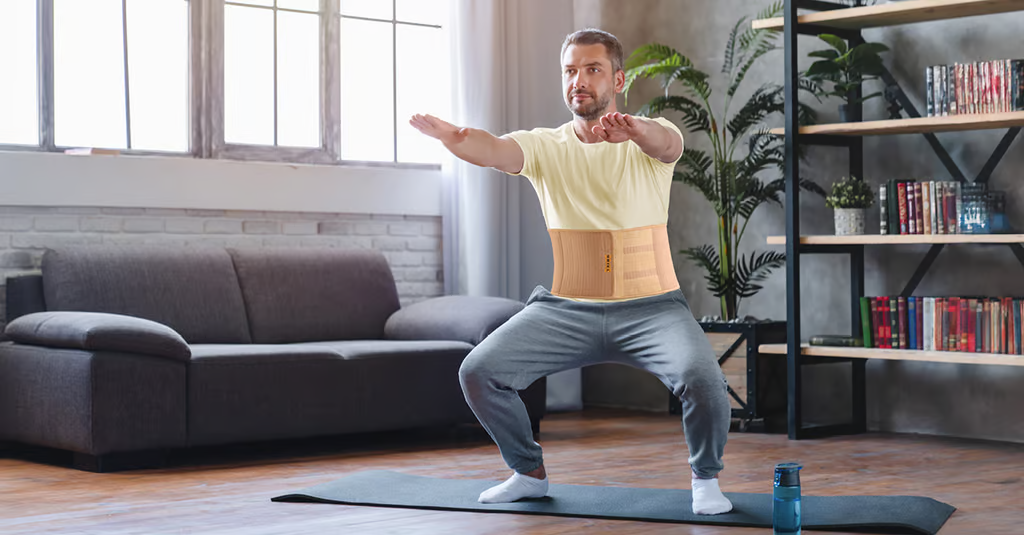
Treating Lower Back Pain: 6 Tips to Improve Quality of Life
Suffering from lower back pain? You are definitely not alone. There are many ways to deal with one of the most common pains in the world, here are some of them. It's time to relieve the pain.
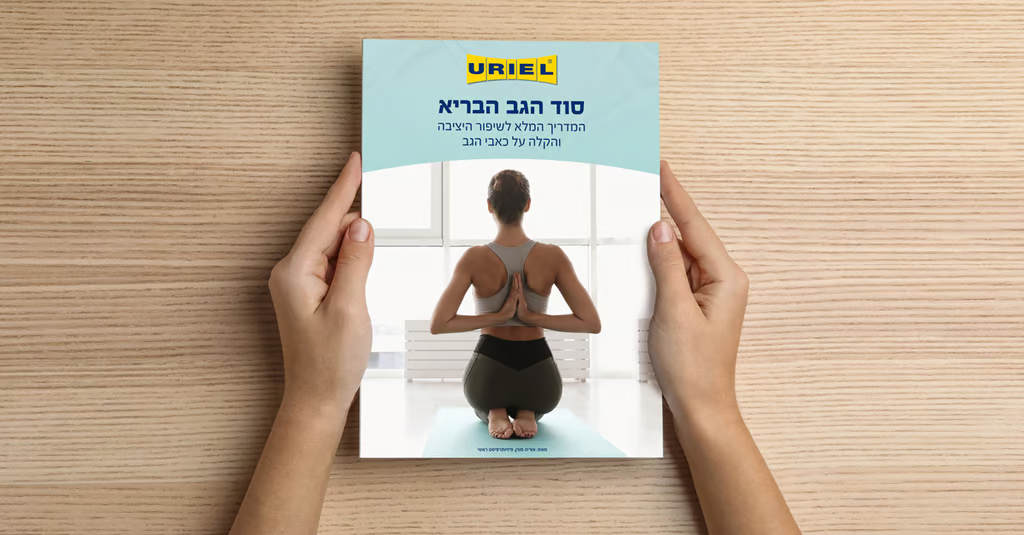
The Secret to a Healthy Back: The Complete Guide to Improving Posture and Alleviating Back Pain
Is back health important to you? Get the 'Secret of a Healthy Back' guide containing information, tips and useful advice for relieving back pain. By Oriya Moran, Chief Physiotherapist Download t...

Kinesio tape or professional elastic bandage?
Suffering from sports injuries, bruises or simply pain caused by medical problems? Get to know the variety of dressing products that will support you. When should we use kinesiology tape and why d...
